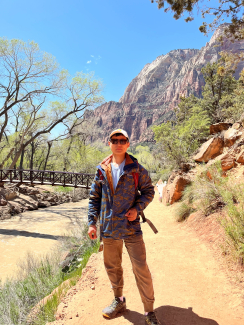While academia has traditionally been the primary path for physicists, the industrial sector offers unique opportunities and advantages. This was certainly the case for Dr. Bin Wang, who was recently a JILA postdoctoral researcher, now a Senior Software Engineer at ASML. “I decided to pursue my career in the semiconductor industry,” explained Wang. “At ASML, we are trying to use photolithographic machines to print very small features on a semiconducting wafer. It works like a projector where a template is projected onto a screen. But our “projector” is not perfect and there is some distortion between what is on the template and what we get on the screen (silicon wafers in our case).”
To overcome this issue, Wang and his team work on designing software systems that can modify patterns on the template to compensate for the distortion. “The software incorporates physics, chemistry, maths, and computer science altogether to get the best correct on the template,” he added.
Before starting at ASML in April of 2023, Wang worked with JILA Fellows and University of Colorado Boulder professors Margaret Murnane and Henry Kapteyn. Wang joined the Murane/Kapteyn research group in 2016 as a graduate student (though he eventually became a JILA postdoc), focusing on specialized ultraviolet light sources and applications.
According to Wang: “The past couple of grad student generations had spent a lot of time and effort developing our coherent EUV light source. So people started thinking about how we could take advantage of this light source and actually use it.”
Expanding on this idea, Wang and other JILA researchers investigated if this light could be used for microscopic imaging. “What I ended up choosing was close to what I'm doing right now,” Wang elaborated. “We were trying to use this short wavelength UV light to build microscopes to image surface details in the nanoscale. We hoped that this could be used in the semiconductor industry to take images of the circuit chips and look for defects.” Current JILA researchers within the Murnane/Kapteyn group continue this research by pushing these imaging techniques to new ultraprecise levels.
As a JILA postdoc, Wang experienced firsthand the supportive nature of the JILA community. He explained: “People were very knowledgeable and willing to share and to teach. So, I learned a lot from Margaret, Henry, and all of the grad students in the group. It was also fun, as we had many snacks and coffee breaks. Our group also took a lot of group trips, which made the grad school life a lot more enjoyable.”
Thanks to his supportive research group and wider JILA community, Wang felt that JILA had helped prepare him when it came time to find a job in industry. Wang elaborated that this support and preparation came in multiple levels, the first being the knowledgeable people around him who could share their wisdom about physics, lasers, and more. “They are world-class experts,” added Wang. “So being around them makes it easier to develop my knowledge and skills in terms of math derivation, thinking about physics problems, tuning the laser systems in the lab, programming, and writing papers and getting published.”
The second level of support that helped prepare Wang for a career in industry was the inviting nature of the bigger JILA community. “I got to know a lot of people during my time at JILA,” said Wang. “Before I came to grad school, I was very shy and not very good at talking to people. Because JILA has so many opportunities to be social with people and join in the community, that helped me a lot in terms of developing English as a second language as well as communication skills.”
Wang also felt grateful to have a large network of alumni to turn to for support when looking to move forward in his career. Thanks to a JILA alumnus, Wang was able to find a job that he enjoys that uses the skills he cultivated within the institute. “I feel like JILA made me not just a better researcher but also, in general, a better person,” Wang added.
Written by Kenna Hughes-Castleberry, JILA Science Communicator



 The Physics Frontiers Centers (PFC) program supports university-based centers and institutes where the collective efforts of a larger group of individuals can enable transformational advances in the most promising research areas. The program is designed to foster major breakthroughs at the intellectual frontiers of physics by providing needed resources such as combinations of talents, skills, disciplines, and/or specialized infrastructure, not usually available to individual investigators or small groups, in an environment in which the collective efforts of the larger group can be shown to be seminal to promoting significant progress in the science and the education of students. PFCs also include creative, substantive activities aimed at enhancing education, broadening participation of traditionally underrepresented groups, and outreach to the scientific community and general public.
The Physics Frontiers Centers (PFC) program supports university-based centers and institutes where the collective efforts of a larger group of individuals can enable transformational advances in the most promising research areas. The program is designed to foster major breakthroughs at the intellectual frontiers of physics by providing needed resources such as combinations of talents, skills, disciplines, and/or specialized infrastructure, not usually available to individual investigators or small groups, in an environment in which the collective efforts of the larger group can be shown to be seminal to promoting significant progress in the science and the education of students. PFCs also include creative, substantive activities aimed at enhancing education, broadening participation of traditionally underrepresented groups, and outreach to the scientific community and general public.